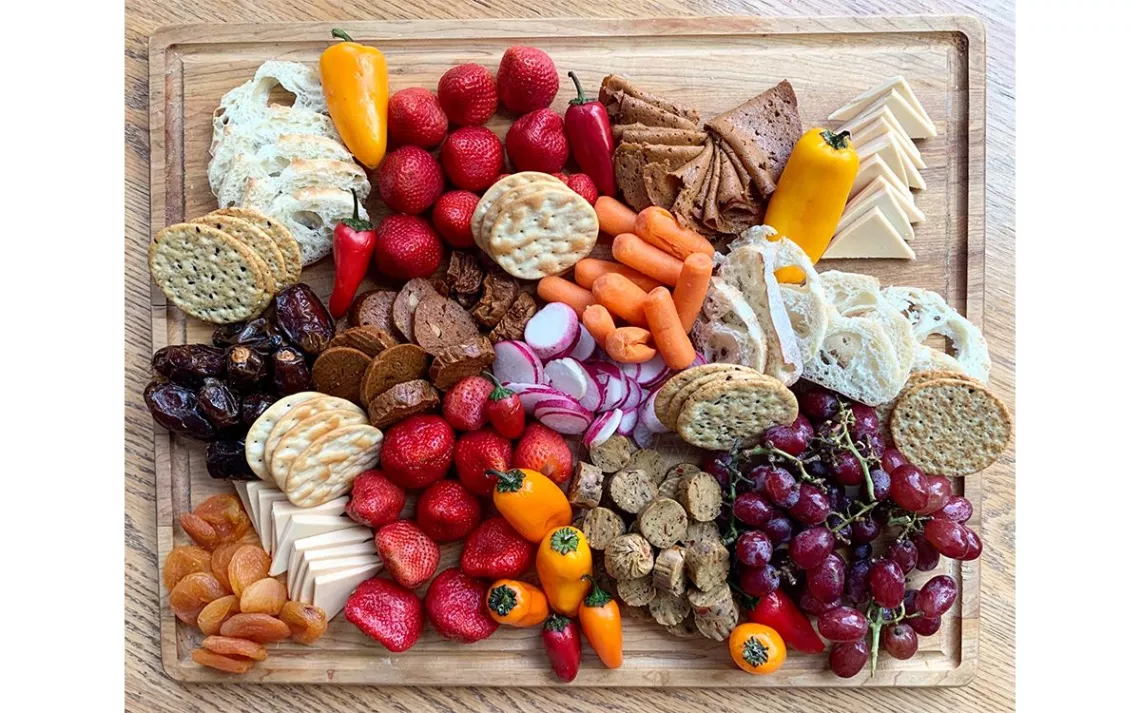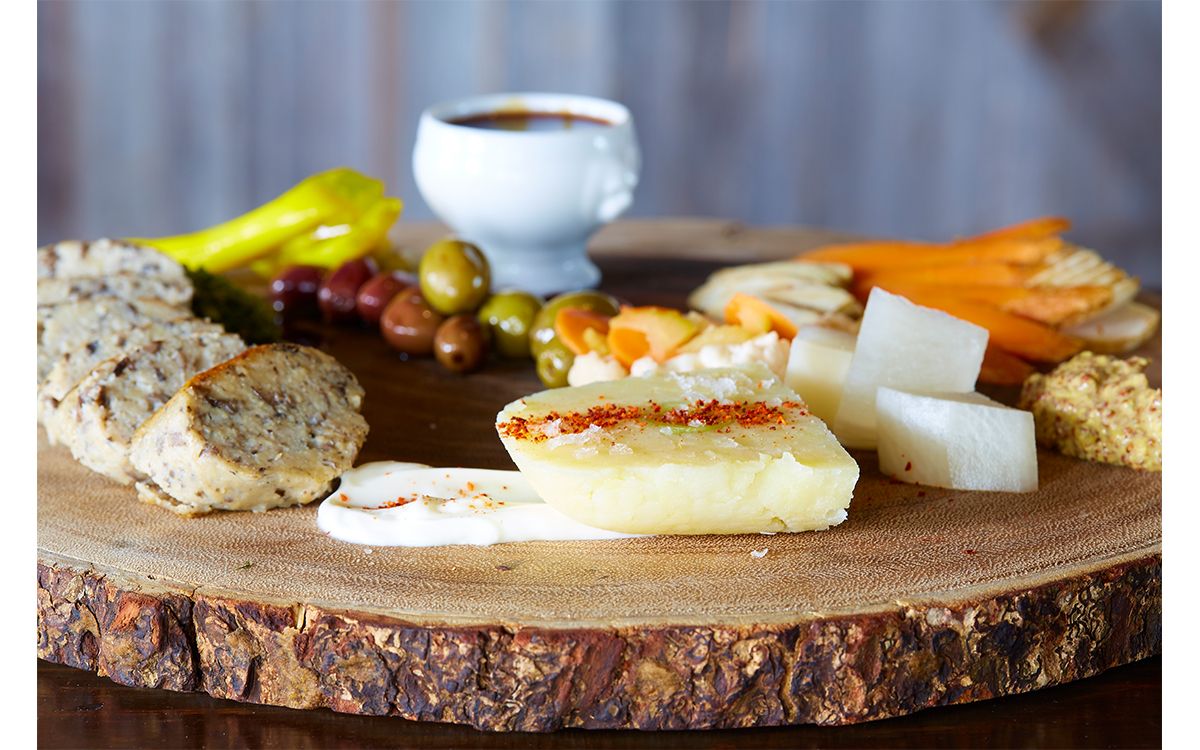Could the Pandemic Greenify Comfort Food?
Plant-based food sales are soaring—and revealing veganism’s indulgent side

Photo courtesy of The Herbivorous Butcher
On a hot afternoon last July in Cleveland, chef Jeremy Umansky stood behind his deli case, carefully arranging a charcuterie tray. At first glance it was an ordinary scene from any deli in the US. But Larder Delicatessen and Bakery doesn’t serve your typical charcuterie. The paper-thin slices—made from locally sourced and smoked beets, squash, and carrots—were listed on the menu alongside more traditional deli fare like pastrami sandwiches, matzo ball soup, and babka, and still are. In fact, ever since the restaurant’s partial reopening in mid-April following a month of closure due to COVID-19, Umansky says Larder’s vegetable-based charcuterie, as well as the veggie burger (made from koji mold, seasonal vegetables, mushrooms, and wheat gluten) tend to sell out within just a few hours.
The coronavirus pandemic struck at a time when global meat demand was declining, largely due to environmental and animal-welfare concerns. Look around the supermarket or browse the local bookstore, and it’s clear that veganism and plant-based cooking aren’t merely trends; they’re increasingly considered part of a more environmentally and politically engaged lifestyle. And, if pandemic book sales are any indication—the majority of Amazon’s top-selling books of 2020 concern bread-baking, eating for better health, and plant-based cooking—Americans are investing in the notion that food is not only a source of fuel and pleasure but also a vehicle for change on a global scale.
They’re also actively changing their eating habits. According to Forbes, the percentage of vegan eaters in the US rose from 1 percent to 6 percent between 2014 and 2017. Data from the UN shows that per-capita meat consumption is expected to fall to its lowest in nine years in 2020 (there’s already been a 3 percent drop from last year).
Restaurant shutdowns likely account for much of the decline, as people tend to eat more meat when they’re out. But it seems Americans are also changing how they grocery shop—a recent study, commissioned by grocer Kroger in partnership with the Plant Based Food Association, showed that after moving plant-based meat alternatives closer to the meat section late last year, Kroger grocery stores saw a 23 to 32 percent increase (depending on the area of the country) in alternative meat sales. And shortly after several states issued shelter-in-place orders in March 2020, grocery stores saw a dramatic 152 percent increase in sales of alternative meats from brands like Beyond and Impossible. Though sales and volume have tapered off slightly since the onset of pandemic panic-buying, these times of great uncertainty seem to have catapulted demand for both plant-based fare and comfort foods.
It helps that vegan fare, which has come a long way from the lackluster veggie pasta and garden salad offerings of the 1990s, continues to see innovation from chefs and grocery manufacturers. Even before the pandemic struck, many restaurateurs had been exploring the notion that plant-based eating could be not only delicious but also celebratory and indulgent—which suggests that even in the After Times, this collective retreat from meat could continue. Sierra checked in with restaurateurs for the latest on trends in the plant-based comfort food world.
The notion that a more indulgent plant-based ethos could expand consumers’ mindset was the thinking behind The Herbivorous Butcher in Minneapolis. Inspired by their Chamorro (Guam) background, the restaurant’s brother-and-sister creators launched The Herbivorous Butcher as a single market stall back in 2014, selling vegan ribs, fried chicken, tuna melts, mac- and cheese (pictured below), and more. They eventually launched a crowd-funding campaign and expanded their business into a full deli, as well as a catering and mail-order operation, through which they ship plant-based products like maple mustard sausage and herb truffle Havarti to customers across the US. In March, they also started offering no-contact curb-side pick-up services. Herbivorous Butcher social media manager Laura VanZandt notes that despite an expected drop in wholesale business, direct customer sales of vegan indulgences have risen throughout the pandemic. “We had our busiest direct-to-consumer shipping week of all time within these past three months.”

In New York, James Beard-nominated chef Amanda Cohen of Dirt Candy has been offering up veggie-based comfort foods since 2008. But since starting out, Cohen has noticed some key differences in customers’ tastes and proclivities.
"Everyone knows they should be eating more vegetables, but they're just not a part of most people's routines,” Cohen says, “but the pandemic shattered everyone's routines and suddenly people had more time to try new things like vegetables and meat alternatives. For a lot of people this was a reset; they suddenly had the breathing room to focus on themselves and their health. Twelve years ago when I opened Dirt Candy, people were pretty astonished just to get vegetables that weren't a side dish. Now their expectations are a lot more sophisticated, so I think all they needed was time. The pandemic has been horrible, but it forced everyone to step off the treadmill.” She adds, “For me it was a tough pivot, because I've gone from doing high-end tasting menus to stoner sandwiches, kitchen sink salads, and meal kits, but I've actually enjoyed it. Applying everything I've learned about smoking, salting, pickling, and frying vegetables to making party food has actually shattered my own routines, maybe for good."
In Dallas, Graham Dodds, former head chef of the steakhouse turned farm-to-table restaurant Hibiscus and the now-defunct Wayward Sons, has spent the past five years putting Texans’ love affair with meat and barbecue to the test, spearheading the creation of vegetarian-based pates, terrines, and sausages. Dodds, who describes himself as “typically averse to any sort of fake meat substitute,” appeals to Texan sensibilities by highlighting vegetables’ inherent similarities to meat, playing off specific types of charcuterie. Think sunchoke pate made to mimic liver mousse in texture and color and sausages made with lentils and mushrooms. Dodds adds, “I made lonzino with carrots, celery root, and parsnips, and coated them with toasted fennel seed. Vegetable terrines would be a component, depending on what was in season and available locally. In summer, we’d highlight a small tomato tartare with a corn puree for the ‘yolk.’”
Dodds is currently developing a menu for Dallas’s Pittman Hotel restaurant (now set to open mid-August at the earliest, having been pushed back from its planned July debut). Vegetable-forward offerings include a mushroom-based Spanish-style “chorizo,” celeriac root and chickpea based “deviled eggs,” and a seasonal tomato tartare, among other, meatier fare. For home cooks looking to add more plant-based ingredients to favorite dishes, Dodds says, the key is to seek out vegetables that mimic that meaty flavor.
“I’m working on a paella dish, so I got a few different types of mushrooms from a local guy who grows them,” he says. “Lion's mane worked well for one, since they look like scallops and absorb the flavors you put with them. I also marinated a king trumpet mushroom with all the spices that typically go into Spanish chorizo—smoked paprika, cayenne, garlic, etc.—and that was a really nice component to it. Chicken of the woods mushrooms would be nice in here too, for more meatiness.”
Rather than the all-or-nothing approach to plant-based eating, chefs are increasingly inviting eaters to think outside the box and embrace the wide variety of plants’ flavors and textures. Take Tanya Holland, well-known in Northern California for her now-shuttered restaurant Brown Sugar. Her new concept, Town Fare, located inside the Oakland Museum of California, will incorporate a “fresh, vegetable-forward, California soul-food-inspired menu.” Holland told Eater San Fransisco that by getting people more excited about eating vegetables, she hopes to make a difference in helping to fix the world’s broken food system. “As a Black woman, as a woman of color, I’m going to be able reach communities that some other chefs won’t be able to.”
When it comes to experimentation and innovation, chefs such as twice-nominated James Beard finalist Jeremy Umansky, of Ohio’s Larder Delicatessen and Bakery, encourage home cooks to get creative with vegetable textures to achieve that meat-like bite. At Larder, he uses an ancient rice-based mold called koji, often found in soy sauce and miso paste, to cure and enrich the flavors of breads, meats, and vegetables. “If a piece of meat went through these same steps, we would call it charcuterie,” Umansky reasons. “So why wouldn’t that extend to a vegetable?”
In his new book, Koji Alchemy; Rediscovering the Magic of Mold-Based Fermentation (Chelsea Green, May 2020), Umansky and cowriter Rich Shih, a miso and koji researcher, share step-by-step vegetable charcuterie creations and show that the concept applies to a wide variety of produce, including beets, carrots, broccoli, squash (winter and summer), and apples. Though some of the recipes/science experiments require precision and strict adherence to instruction, Umansky also urges home cooks to throw out the rulebook and cook whatever they consider to be delicious. “Remember that just because someone told you that you have to peel a potato or carrot before you cook and eat it doesn’t mean that it’s the right thing to do,” he writes. “Why waste a tasty and valuable part of your food and make more work for yourself? Treat your vegetables as you would another person—with dignity, love, and respect—and they’ll treat you back that way in kind.”
The pandemic continues to bring to light the many flaws within global food systems; namely, the enormous pressures they currently place on the planet and its people. This year, plant-based eating has inched closer than ever before to center stage, and it shows great potential to expand. With each new chef, cookbook, and food manufacturer embracing the potential of plants, the market expands to include not only more alternative meat-based products for middle-class supermarket-goers and restaurant diners, but also access to fresh produce for those of all socioeconomic backgrounds. Who knows? In just a few years’ time, we may find ourselves looking back at our old eating habits and wondering why we ever thought so narrowly about produce, when there was so much to discover.

Photo by Kevin Marple and courtesy of Wayward Sons
This article has been updated since publication.
 The Magazine of The Sierra Club
The Magazine of The Sierra Club







